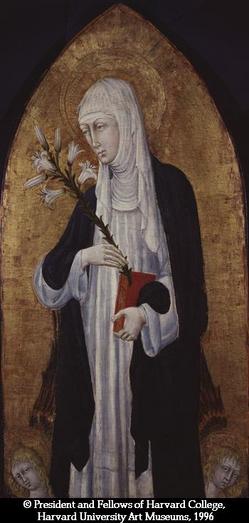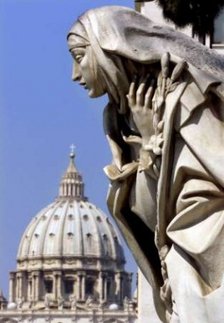Pope Benedict spoke in his General Audience today of the great 14th century Dominican sister, Saint Catherine of Siena, holy woman, ambassador, truth-speaker, Doctor of the Church and spiritual mother. His choice of saint could not have been better since the presence of many of the new cardinals were in attendance. Rome Reports provides a brief video clip on the papal address.

Today I would
like to speak to you about a woman who has had an eminent role in the history
of the Church. She is St. Catherine of Siena. The century in which she lived --
the 14th -- was a troubled time for the life of the Church and for the
whole social fabric in Italy and Europe.
However, even in the moments of greatest difficulty, the Lord does not cease to bless his People, raising men and women saints who stir minds and hearts, bringing about conversion and renewal. Catherine is one of these and still today she speaks to us and pushes us to walk courageously toward sanctity to be disciples of the Lord in an ever fuller sense.
Born in Siena in 1347 to a very numerous family, she died in her native city in 1380. At 16, moved by a vision of St. Dominic, she entered the Dominican Third Order, in the feminine branch called the Mantellate. She stayed with her family and confirmed the vow of virginity she made privately when she was still an adolescent; she dedicated herself to prayer, penance, and works of charity, above all for the benefit of the sick.
When her fame for sanctity spread, she became the protagonist in an intense activity of spiritual counsel, dealing with all categories of persons: nobles and politicians, artists and ordinary people, consecrated persons, ecclesiastics, and including Pope Gregory XI, who at that time resided in Avignon and whom Catherine exhorted energetically and effectively to return to Rome. She traveled a lot to solicit the interior reform of the Church and to foster peace between states. For this reason also the Venerable John Paul II declared her co-patroness of Europe: so that the Old World would never forget its Christian roots that are at the base of its journey and continue to draw from the Gospel the fundamental values that ensure justice and concord.
Catherine learned to read with effort and learned to write when she was already an adult. Her doctrine is contained in The Dialogue of Divine Providence or Book of Divine Doctrine, a masterpiece of spiritual literature in a collection of letters and prayers. Her teaching is gifted with such richness that, in 1970, the Servant of God Paul VI declared her a doctor of the Church, a title that was added to that of co-patroness of the city of Rome, by the decision of Blessed Pius IX, and of patroness of Italy, by the decision of the Venerable Pius XII.

In a vision that never left Catherine's heart and mind, Our Lady presented her to Jesus who gave her a splendid ring, saying to her: "I, your Creator and Savior, espouse you in the faith, which you will always keep pure until you celebrate with me in heaven your eternal nuptials" (Raimondo da Capua, S. Caterina da Siena, Legenda maior, n. 115, Siena 1998). That ring was visible only to her. In this extraordinary episode, we see the vital center of Catherine's religiosity and of every authentic spirituality: Christocentrism. Christ was for her a spouse, with whom she had a relationship of intimacy, communion and faithfulness; he is the cherished good above any other good.
This profound union with the Lord is illustrated by another episode in the life of this famous mystic: the exchange of hearts. According to Raymond of Capua, who transmitted the confidences received by Catherine, the Lord Jesus appeared to her with a bright red human heart in his hand, opened her chest and placed it in her, and said: "Dearest daughter, as the other day I took your heart that you offered to me, behold now I give you mine, and henceforth it will be in the place that yours occupied" (ibid.). Catherine truly lived St. Paul's words, "It is no longer I who live, but Christ who lives in me" (Galatians 2:20).
Like the Sienese saint, every believer feels the need to be conformed to the sentiments of the heart of Christ to love God and neighbor as Christ himself loves. And we can all let our hearts be transformed and learn to love like Christ, in a familiarity with him nourished by prayer, meditation on the Word of God and the sacraments, above all by receiving Holy Communion frequently and with devotion.
Catherine also belongs to that rank of Eucharistic saints with which I concluded my apostolic exhortation Sacramentum Caritatis (cf. No. 94). Dear brothers and sisters, the Eucharist is an extraordinary gift of love that God continually renews to nourish our journey of faith, reinvigorate our hope, inflame our charity, to make us ever more like him.
A true and authentic spiritual family was built up around such a strong and genuine personality: people fascinated by the authoritative morality of this young woman of an elevated style of life, and at times impressed also by the mystical phenomena they witnessed, such as the frequent ecstasies. Many placed themselves at her service and above all considered it a privilege to be guided spiritually by Catherine. They called her "mamma," because as spiritual children they received the nourishment of the spirit.
Today also the Church receives great benefit from the spiritual maternity of so many women, consecrated and lay, who nourish in souls the thought of God, reinforce people's faith and orient Christian life toward ever higher summits. "Son I say to you and call you," wrote Catherine addressing one of her spiritual sons, the monk Giovanni Sabbatini, "inasmuch as I give you birth by continuous prayers and desire in the presence of God, just as a mother gives birth to a son" (Epistolario, Lettera n. 141: To don Giovanni de' Sabbatini). She would usually address the Dominican friar Bartolomeo de Dominici with these words: "Most beloved and very dear brother and son in Christ sweet Jesus."
Another trait of Catherine's spirituality is connected with the gift of tears. They express an exquisite and profound sensitivity, a capacity for being moved and tenderness. Not a few saints have had the gift of tears, renewing the emotion of Jesus himself, who did not hold back and hide his tears before the sepulcher of his friend Lazarus and the sorrow of Mary and Martha, and on looking at Jerusalem in his last days on earth. According to Catherine, the tears of saints are mixed with the blood of Christ, of which she spoke with very effective vibrant tones and symbolic images: "Remember Christ crucified, God and man (...). Put before you as object Christ crucified, hide in the wounds of Christ crucified, drown in the blood of Christ crucified" (Epistolario, Lettera n. 16: To one whose name is withheld).

Here we are able to understand why Catherine, though aware of the human defects of priests, always had great reverence for them: Through the sacraments and the Word they dispense the salvific strength of the blood of Christ. The Sienese saint always invited the sacred ministers, including the Pope, whom she called "sweet Christ on earth," to be faithful to their responsibility, moved always and only by their profound and constant love of the Church. Before dying she said: "Leaving the body I, in truth, have consumed and given my life in the Church and for the Holy Church, which is for me a most singular grace" (Raimondo da Capua, S. Caterina da Siena, Legenda maior, n. 363).
Hence, from St. Catherine we learn the most sublime science: to know and love Jesus Christ and his Church. In the Dialogue of Divine Providence, she, with a singular image, describes Christ as a bridge flung between heaven and earth. It is made up of three steps constituted by the feet, the side and the mouth of Jesus. Raising itself by these steps, the soul passes through the three stages of every path of sanctification: detachment from sin, practice of the virtues and of love, sweet and affectionate union with God.
Dear brothers and sisters, let us learn from St. Catherine to love Christ and the Church with courage in an intense and sincere way. Hence, let us make our own the words of St. Catherine that we read in the Dialogue of Divine Providence, at the end of the chapter that speaks of Christ-bridge: "Through mercy you have washed us in the blood, through mercy you wished to converse with creatures. O Madman of love! It was not enough for you to incarnate yourself, but you also wished to die! (...) O mercy! My heart drowns in thinking of you: for no matter where I turn to think I find only mercy" (chapter 30, pp. 79-80).


Thanks for posting the Holy Father's address on St Catherine of Siena. As a recent convert reading about the lives of saints and doctors of the church such as these is a great source of inspiration for me. I have been suffering from an illness for three years. To see the way Catherine and Therese offered up there suffering as a powerhouse of prayer for reparation of the holy souls and sinners reminds me that the pain of this life is not in vain. I hope that may own suffering brings me to a closer union with Christ and His Divine will.
Thanks again!